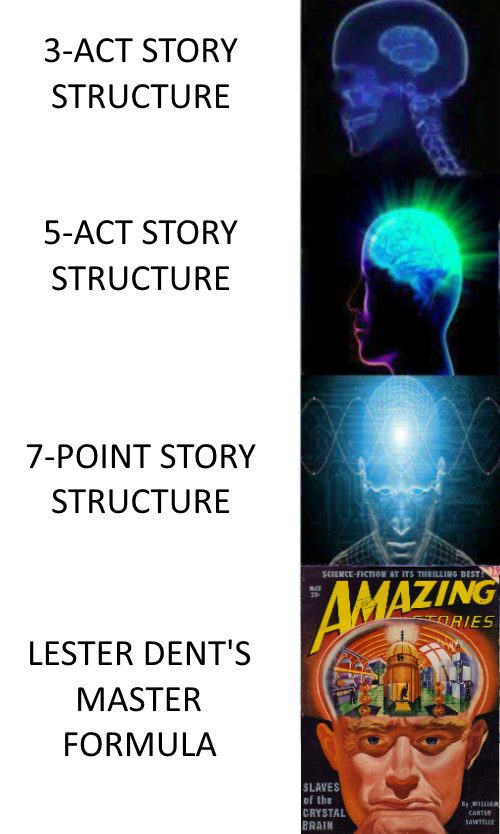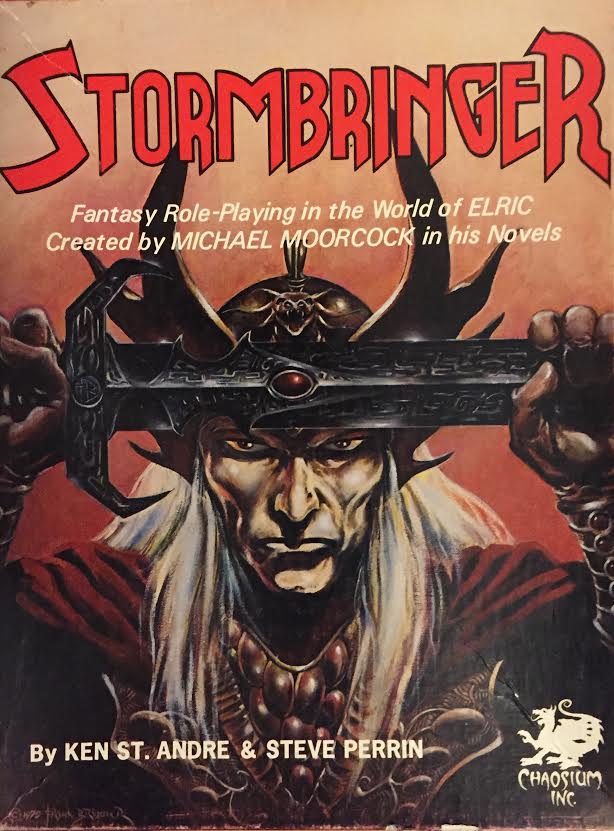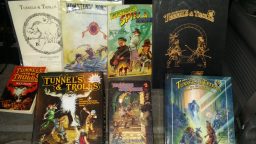 Ken St. Andre’s role in the earliest stages of the development of a roleplaying games can be summed up in one sentence. It’s on the opening page of the first edition of Chaosium’s Runequest, where a small note reads, “DEDICATED to Dave Arneson and Gary Gygax, who first opened Pandora’s Box, and to Ken St. Andre, who found it could be opened again.” His game Tunnels & Trolls was playable, comprehensible, and influential… and hits the table regularly to this day. I believe it is the spiritual forbear to both the Basic Set concept that has become most peoples entry point into fantasy role playing and also a significant influence on what would become the GURPS rule set.
Ken St. Andre’s role in the earliest stages of the development of a roleplaying games can be summed up in one sentence. It’s on the opening page of the first edition of Chaosium’s Runequest, where a small note reads, “DEDICATED to Dave Arneson and Gary Gygax, who first opened Pandora’s Box, and to Ken St. Andre, who found it could be opened again.” His game Tunnels & Trolls was playable, comprehensible, and influential… and hits the table regularly to this day. I believe it is the spiritual forbear to both the Basic Set concept that has become most peoples entry point into fantasy role playing and also a significant influence on what would become the GURPS rule set.
Ken St. Andre graciously agreed to talk to me back in 2015 when I was working on my book about Appendix N. Now he’s back again to talk about games, pulp, and– even better!– pulp and games together!
—
Jeffro: Well, it’s been about a year and a half since the last time we spoke. And this is going to be hard for some people to believe, but back then (it seems ages ago!) I was incredulous when you tried to tell me that the original Tarzan stories were awesome. The idea that they could be synonymous with fantasy for someone was positively mind-blowing. That they were a primary inspiration on the second role-playing game ever created was baffling.
I wasn’t sure how all of this would go over when I set myself to getting the word out about it. You can see me taking pains to not oversell it initially as this was all too outrageous to be conceivable. But among the dozen or so people that have taken the time to look into this for themselves and write reviews on the subject, things seem to have swung in the opposite direction. For them, it’s now impossible to imagine the fantasy and science fiction canon with Edgar Rice Burroughs in any other position than a place of honor.
You know… you’re well within your rights if you just come right out and say, “I told you so.”
Ken St. Andre: I try to avoid saying “I told you so” except as a joke, but it’s always nice to get confirmation of one’s own beliefs from others.
So, I’ve never read Appendix N. I never followed the pronouncements of the great Gygax. I don’t hang with that crowd. Did he mention the great pulp authors at all? Doc Smith, Edmond Hamilton, Leigh Brackett, Henry Kuttner, C. L. Moore, even L. Ron Hubbard or Lester Dent?
Jeffro: The compilation of the Appendix N list was a group effort– Tim Kask has thankfully settled the question of whether or not it was “Gygax’s list” once and for all, thankfully. (Detractors of classic authors such as Fritz Leiber and even Jack Vance invariably diminish Appendix N as being “just a list of books that Gygax liked.”)
The game developers at TSR seemed to have preferred the planetary romance of Edgar Rice Burroughs and Leigh Brackett over the space opera of Doc Smith and Edmond Hamilton.
Leigh Brackett is on the list, and fans of Appendix N are especially vociferous in their praise for her works. (And I note that the term space opera seems to have become much more specialized in recent years: if it doesn’t have epic space battles and exploding planets, then it’s not space opera to some. Which is odd as it tends to exclude the work of “the queen of space opera”!!)
C. L. Moore is the author that is requested for inclusion into the Appendix N list more than any other, though I suppose Ursula Le Guin can give her a run for her money. Appendix N fans are astonished at how well she wrote, how Jirel of Joirey is not just a gender-swapped Conan-clone, and how Han Solo antecedent Northwest Smith is overwhelmed and upstaged by his feminine foils.
Henry Kuttner is by far overshadowed by his wife. You don’t hear so much about him, and I wonder if some of the work he collaborated on with her is incorrectly attributed to Moore alone.
Lester Dent is not on the list, but connoisseurs of pulp swear by him. I believe Jon Mollison is putting his methods back into practice in his own short fiction.
L. Ron Hubbard… you really don’t see his name come up in anything like a positive light. If Gygax and company were not heavy into space opera, they were even less taken with the inner circle of the Campbellian Revolution. These are the people most associated with “real” science fiction: Asimov, Clarke, Heinlein, Herbert, and so on. That’s the most shocking thing to me about looking back at the old role-playing games of the seventies. The authors that are most often characterized as “classic” outside of gaming practically didn’t exist for the designers. Science fiction in the mid-seventies would have been more along the lines of Brian Aldiss, E.C. Tubb, Poul Anderson, H. Beam Piper, Sterling Lanier, and Fred Saberhagen– all authors that really don’t come up so much at all these days!
Anyway, Appendix N is incomplete. It is a subset of the fantasy and science fiction canon. A lot of people want to add all kinds of stuff to it for all kinds of reasons. But most of the stuff they want to add just doesn’t fit with the times that it emerged from. The authors you just mentioned there, though…? They fit. They’re the ones that people that like reading “pulp” rave about and insist that everybody should read.
Ken St. Andre: Anne McCaffrey did write space opera, but her Pern novels were not. Ship that Sang series is prime space opera. Many of her other books too. Dragonflight books–no. In my humble opinion, they are science fantasy.
I thought Appendix N was specifically Gary’s list or bibliography of people to read. I actually did one of those for one of the Sorcerers Apprentice magazines.
Jeffro: I did not know about the Sorcerers Apprentice list! I reverse engineered one based on the references to books in the first five editions of Tunnels & Trolls. But this would be a lot better.
The key line from the Appendix is, I think, “The most immediate influences upon AD&D were probably de Camp & Pratt, REH, Fritz Leiber, Jack Vance, HPL, and A. Merritt.” That would be the point where the tone shifts from Gygax’s fantasy testimony to something approaching an objective claim about what the book list really was. Most people don’t believe the list is anything other than “Gary’s list.” But at the same time, nobody would believe that AD&D is solely the result of Gygax’s efforts. This doesn’t add up!
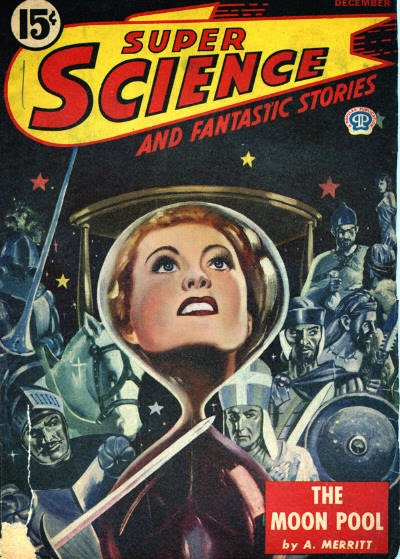 The thing that would blow most people’s minds these days is someone like A. Merritt being part of “the big six” of AD&D inspirations… with J. R. R. Tolkien being left out in the cold! Most people would argue that this was to avoid lawsuits with the Tolkien estate. But then again, most people these days don’t have any idea who the real “Lord of Fantasy” is!
The thing that would blow most people’s minds these days is someone like A. Merritt being part of “the big six” of AD&D inspirations… with J. R. R. Tolkien being left out in the cold! Most people would argue that this was to avoid lawsuits with the Tolkien estate. But then again, most people these days don’t have any idea who the real “Lord of Fantasy” is!
Ken St. Andre: Merritt was brilliant, a much better and more emotional writer than Tolkien, imho.
Not sure I could find that list again. I think Steve Crompton still has all the S.A. material. I don’t. He’s kinda too busy to look for it for the next month.
Jeffro: Okay, enough about that other game. Let’s talk about Tunnels & Trolls!
Imagine somebody has the crazy idea of recreating what the original Tunnels & Trolls experience was like– or at least, something approaching it. They have printed out their PDF copy of the first edition rules. They have some slots lined up at a big time gaming convention. But then they get to page 5 and their heart sinks: to do it the first edition way, they have to go do the “digging the dungeon” thing first, and they have no idea really of where to begin with that. Imagination is just not their strong point!
Now… first edition would have come out before the bazillion rule sets and adventure modules we take for granted today. What books and stories and authors would you suggest this person read in order to get them pointed in the right direction, to prime the pump as it were? They know they’re kind of crazy to want to do this. But they want to give people a chance to experience something resembling those first Tunnels & Trolls campaigns. What should they read in order to get in tune with the spirit of that initial scene? What’s going to be most immediately useful in getting started here?
Ken St. Andre: They should probably get every Fritz Leiber Gray Mouser and Fafhrd book they can find and read those. Those characters found themselves in more dungeon-esque situations than any other heroes of swords and sorcery. For example: Bazaar of the Bizarre. The bazaar is full of magical traps and treats, and has a few guardian monsters. Continue reading any other Mouser stories and you will see all sorts of inventive magical treasures and fightable foes–sometimes human, sometimes not. If the potential GM has more time he could read some Greek mythology. Jason and the Argonauts are quintessential dungeon delvers, facing challenge after challenge on their way to an ultimate prize. Or read the Odyssey. Odysseus or Ulisses as he is sometimes called gets into all sorts of dungeon-like situations. Have the way in guarded by a cyclops; let there be a room full of tantalizing food that turns men into beasts or monsters, let there be a narrow passage between two monsters–Scylla and Charybdis (or invent your own). Or take the story of Theseus and the minotaur and condense it. The Labyrinth is a dungeon. The minotaur is the ultimate monster, but to make things interesting, let’s add a few lesser monsters that live inside the Labyrinth. How about some Greek-styled goblins, miniature green Greek warriors armed with Bronze Age weapons. For the proper feel read the Moria section in Tolkien’s Fellowship of the Ring–magic door, lake monster, dark and dangerous tunnels, orcs, an ultimate challenge, and finally a great reward at the end. Or for a real quick surge of inspiration just watch some of the Sinbad movies that Ray Harryhausen made–underground adventure and monsters galore. Sources of inspiration are endless. Probably the best advice I could give the brand new dungeon master is to remember some piece of fantasy or adventure that he/she really loved, and then adapt that to their own purposes.
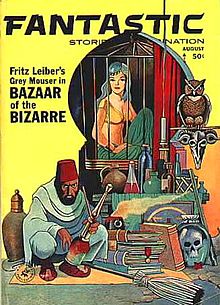 It is somewhat inconceivable to me that anyone would dare be a Dungeon Master or a Game Master without a strong grounding in fantasy of some sort–whether it just be movies, or knowledge of mythology, or a favorite author or six like Burroughs, Howard, Lovecraft, Tolkien, De Camp, Moorcock, Leiber, and Carter. The aspiring GM in 1975 should just pick something they love as a model and then “dig” the dungeon around it. My first dungeon was very Tolkienian–trolls, dwarves, and a balrog. Liz Danforth’s first dungeon was built around the ideas in the movie called “The Phantom of the Paradise” which came from the older “Phantom of the Opera”. Take something you like, tweak it a little, and have fun.
It is somewhat inconceivable to me that anyone would dare be a Dungeon Master or a Game Master without a strong grounding in fantasy of some sort–whether it just be movies, or knowledge of mythology, or a favorite author or six like Burroughs, Howard, Lovecraft, Tolkien, De Camp, Moorcock, Leiber, and Carter. The aspiring GM in 1975 should just pick something they love as a model and then “dig” the dungeon around it. My first dungeon was very Tolkienian–trolls, dwarves, and a balrog. Liz Danforth’s first dungeon was built around the ideas in the movie called “The Phantom of the Paradise” which came from the older “Phantom of the Opera”. Take something you like, tweak it a little, and have fun.
Jeffro: Digging a dungeon is the focus of the earliest editions of Tunnels & Trolls… but the Dungeon Master is going to find people and places springing up in its vicinity even though the rules are silent on the matter. The game world naturally seems to take on a life of its own! In 1979 with the 5th edition of the game, a new elaboration is added to the game: “More About City, World, & Dungeon Building”. In it it says, “we cannot urge you strongly enough to exercise your wit, time, and imagination (as well as your time, energy, and maybe a little cash) in creating your own people, places, and things.” Today it’s going to be hard for some people to really imagine this being pitched as a de facto best practice for fantasy gaming– there’s just so many elaborate game settings available on the market these days, after all! But from a design stand point and based on how these games tend to work in practice, do you think this is still good advice for today?
Ken St. Andre: I do think so, absolutely. The more involved the G.M. gets with the world, the better the experience is likely to be for her players. Plus, one improves with practice. Get started in the business of character or scenario creation, and you will get better at it as you go along. Thus, your future creations will be better than your past ones. But if you always rely in scenarios and settings and NPCs created for you by some game designer, then you will only improve at reading modules–you won’t get that much better as a GM.
Jeffro: Do you have any reminiscences of any encounters you had with some of the greats of fantasy and science fiction…? Roger Zelazny or Fritz Leiber maybe…?
Ken St. Andre: Yeah, I do. lots of them. exact details are fading over time. Are fuzzy ones okay?
Jeffro: Oh certainly! Anything you can recall is of interest!
Ken St. Andre: I’m kind of hesitant to say anything because I don’t really have anything to prove my claims any more. Let me see what I can recover.
Okay, here’s an autograph I got from him. Do you see how relatively small but readable and elegant it is? Roger was a very kind and gentle person as far as I could tell. Very smart. A master of the English language. For years my friends and I would ask him for autographs every time we saw him at a convention. Finally, Flying Buffalo published a a book of T&T fantasy stories. Me, Liz Danforth, Mike Stackpole–we all had stories in it. So, in my youthful naivety I gave Roger a copy of it, and he kindly accepted it with a grin, and then said, now I get to ask you for an autograph. He was that kind.
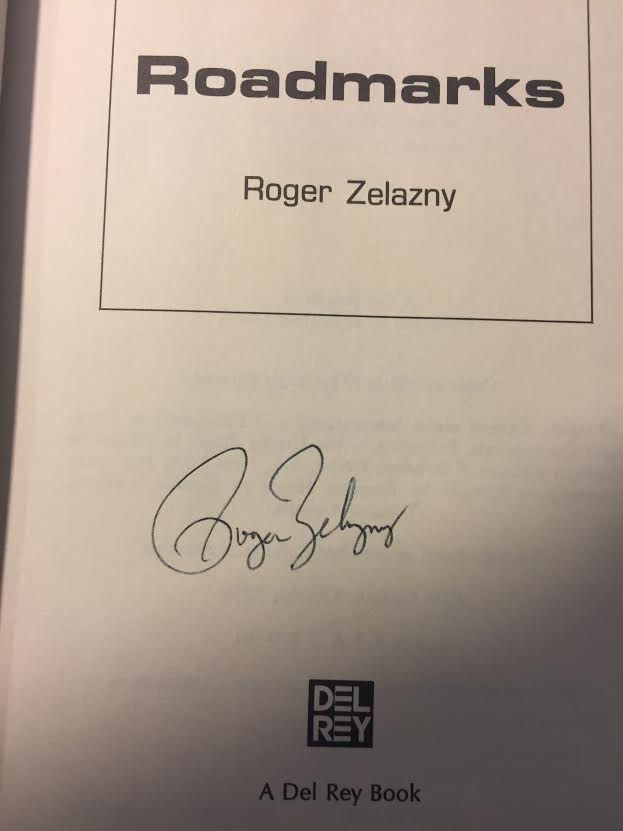
I’ve forgotten what year it was, but probably early 80s, Mike Stackpole and I drove from Phoenix to Denver to attend a MileHiCon and we asked Roger ahead of time if we could stop and visit him. He agreed to allow it. He had a very fine home in the Santa Fe mountains with a window that stretched from the north wall to the south wall of the library/office where he wrote. He received us in that room. Roger gave me a Thomas Canty drawing of Princess Fiona on that trip. We found out that he paid for the house with the money he made selling the film rights for Damnation Alley. That was probably his worst book ever. Not his favorite book, but the one that gave him the best financial reward. Another year we attended MileHiCon again because Roger was Guest of Honor that year. A bunch of us from the Phoenix area went to the Con: Me, Liz Danforth, Pat Mueller, and Tim Kask, I think. The big event of the Con was a trivia contest–not between individuals but between teams. We formed a team called the Knights of the Iguana. (The 1978 WorldCon was held in Phoenix and was called IguanaCon.) Roger also had a team consisting of him and other guests of the Con. The Contest was set up like a tv quiz show–like Family Feud or something. The moderator would ask a question, and if you thought you knew the answer, you would hit a buzzer. There were some 8 teams, but the final matchup came down to Roger’s team vs. my team. I had a strategy for the game. If I knew the answer I would hit the buzzer at once. If I didn’t, I would wait about 5 seconds to see if anyone else on my team knew the answer, and if no one did, I hit the buzzer and guessed. Many of the questions had to do with comic book history and trivia. On those questions it was always a race between Roger and me to see who would know the answer. It was the only time I ever competed against him. (My team won that contest. Kinda felt bad beating Roger. We all liked and admired him.)
IguanaCon in 1978 was when we first met Fritz Leiber. I was already a big fan of his. Fritz attended. On the last day of the Con, Fritz read a short H. P. Lovecraft story to a crowd of listeners. Liz and Pat and I were in the audience of course. He was spellbinding. He did voices and sound effects. Afterwards we invited him to go out to dinner with us and he accepted. We took him to our favorite Chinese restaurant, and we all had a wonderful time. A few years later we were attending a gaming convention in San Francisco. That’s where Fritz lived–in a loft in a rundown building down near the waterfront. Liz, Pat, Mike, and I borrowed the Flying Buffalo van and went to see him one night. To reach his apartment you had to take an old style cage elevator–slow as molasses–up to an upper floor. His apartment was crowded with books, trophies, and awards, including some Nebulas and Hugos, but the thing that made the biggest impression on me was a pistol in a display case. It was an old German pistol and he’d labeled it: Gray Mauser.
Good times.
Jeffro: That’s epic. Wow.
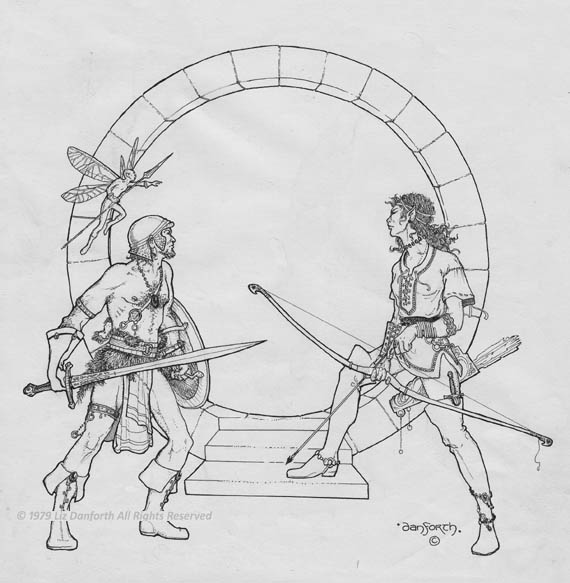 Okay, one of my favorite things about Tunnels & Trolls is the Rogue character type. It’s something very different from the Thieves, Scouts, Swashbucklers, and, well… Rogues from all those other games. Their ability to do some magic is something that has dropped away from the archetype over the years, but as Oakes Spalding pointed out in his retrospective on first edition Tunnels & Trolls, one of the things that makes T&T Rogues roguish is the fact that the pick up their magic from outside the traditional route with the wizard’s guild.
Okay, one of my favorite things about Tunnels & Trolls is the Rogue character type. It’s something very different from the Thieves, Scouts, Swashbucklers, and, well… Rogues from all those other games. Their ability to do some magic is something that has dropped away from the archetype over the years, but as Oakes Spalding pointed out in his retrospective on first edition Tunnels & Trolls, one of the things that makes T&T Rogues roguish is the fact that the pick up their magic from outside the traditional route with the wizard’s guild.
With the elaborations in your new Deluxe Tunnels & Trolls, Rogues get an all-new Roguery talent equal to the best of their luck, intelligence, and charisma attributes plus 2d6. This seems to give them a “special something” more in line with what the other types have always had. Can you give me some additional direction on how to use this talent? Maybe an example or two? (I have ideas of how I would run it, but if I have you here I really would like to know more about what you think.)
Ken St. Andre: Warriors have the weapons bonus. Mages have their magic, no longer limited by their character level, only by their attributes. Rogues needed something. The Roguery talent was meant to be a catch-all to allow any moderately inventive player to get away with all kinds of tricks. To tell the truth, I haven’t had a chance to do much with it, or see it in action very often. I only hope it works to make rogue characters as much fun to play as the other two archetypes.
Jeffro: The first time I ever heard of Tunnels & Trolls was in the introduction to the second edition of GURPS. Steve Jackson cites the system for its support for solitaire gamers, but coming to T&T from GURPS, I was astonished to see as much “advanced” game design there as I did. Weapon damage is (more or less) a function of strength. Attributes define most of what really matters about a character. Saving rolls against the prime attributes– rather than a hodgepodge of kludges– form the core game mechanic that play is based on. If Traveller and T&T are games that were made by people that picked up the original “little brown books” of OD&D and then made their own game… then it’s possible that Steve Jackson’s The Fantasy Trip was like that… except it was created by someone that was working off of your game.
And I know… it’s been a long time since you worked on Monsters! Monsters! with Steve Jackson and MetaGaming Concepts. But as someone that worked with Steve Jackson at the very dawn of the hobby, do you have any recollections on this or any insight into how things played out like they did? (Even if it’s a little hazy…?)
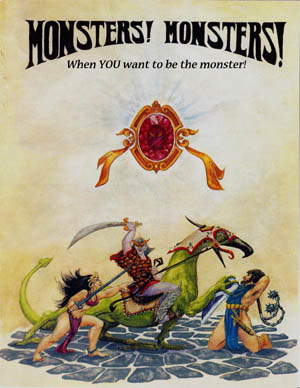 Ken: I wish I could say that Steve and I worked hand-in-hand to produce the first edition of Monsters! Monsters! But that simply isn’t true. Howard Thompson, owner/creator/leader of Metagaming, Inc. contacted me originally for a fantasy role-playing game. I offered him Monsters! Monsters! Liz Danforth did the art. Howard put Steve in charge of producing/editing the game. He never contacted me at all about it, and I think the game is pretty much as I wrote it. And as Liz drew it. Metagaming didn’t last very long. Howard disappeared. Steve took over and turned it into Steve Jackson games. Steve and I used to see each other at game conventions back in the late 70s and were casual friends, but never really close. When Metagaming went out of business I reacquired the rights to Monsters! Monsters! for $300. Then pretty much sold them to Rick Loomis and Flying Buffalo to recover my $300. Back in the late 70s $300 was a lot of money to me. Flying Buffalo did two editions of Monsters! Monsters! and a reprint this century, but never made any significant changes in the game text or art. The Monsters! Monsters! rules and the Tunnels & Trolls 1st edition available on drivethrurpg are as close to the original role-playing experience for me and my friends as anyone can get at this time.
Ken: I wish I could say that Steve and I worked hand-in-hand to produce the first edition of Monsters! Monsters! But that simply isn’t true. Howard Thompson, owner/creator/leader of Metagaming, Inc. contacted me originally for a fantasy role-playing game. I offered him Monsters! Monsters! Liz Danforth did the art. Howard put Steve in charge of producing/editing the game. He never contacted me at all about it, and I think the game is pretty much as I wrote it. And as Liz drew it. Metagaming didn’t last very long. Howard disappeared. Steve took over and turned it into Steve Jackson games. Steve and I used to see each other at game conventions back in the late 70s and were casual friends, but never really close. When Metagaming went out of business I reacquired the rights to Monsters! Monsters! for $300. Then pretty much sold them to Rick Loomis and Flying Buffalo to recover my $300. Back in the late 70s $300 was a lot of money to me. Flying Buffalo did two editions of Monsters! Monsters! and a reprint this century, but never made any significant changes in the game text or art. The Monsters! Monsters! rules and the Tunnels & Trolls 1st edition available on drivethrurpg are as close to the original role-playing experience for me and my friends as anyone can get at this time.
Jeffro: Speaking of old things recently made available again… I want to thank you and your people for getting 5th Edition Tunnels & Trolls and Mercenaries, Spies, and Private Eyes out in PDF format. Among connoisseurs of fine gaming, those two books are highly regarded and it’s great to finally get a look at them. I’m amazed at how ahead of its time MSPE is. It folds together elements of both The Fantasy Trip and Call of Cthulhu to make a surprisingly robust system. Its psionics system seems to anticipate the one Steve Jackson would go with for GURPS Horror. You guys were spitting distance from dropping an eminently playable “Generic Universal System” on the market years before Steve Jackson would get around to it.
I don’t understand why this is such a secret. I mean Grimtooth’s Traps was everywhere back in the day. But I never heard of Tunnels & Trolls outside of the introduction to GURPS. What happened?!
Ken St. Andre: Obviously, you didn’t look for it, Jeffro. A web search of any kind would have found numerous references to Tunnels & Trolls. But we didn’t get much publicity back then. No advertising budget. No store presence. Grimtooth was connected to the Traps books which were generic–for any system. That was long before social media became a thing. There was no Facebook, no Twitter, no Instagram, nada, zip, zilch.
Jeffro: Well I missed out. I think 5th edition Tunnels & Trolls and Mercenaries, Spies, and Private Eyes would have gotten a lot more actual play than the pile of rpgs I did have. Especially if I had some Fritz Leiber paperbacks to go with them!
Did you have anything else you wanted to get into here? Any other books or games or authors you wanted to make sure get mentioned…?
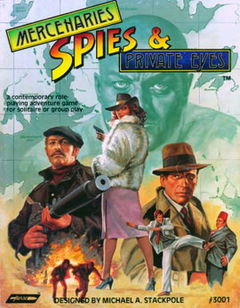 Ken St. Andre: I don’t think I’ve mentioned the effect that comics and movies had on the creation of Tunnels & Trolls and Monsters! Monsters! For example, I knew after the first cursory examination of That Other Game that character creation was limited to a narrow range of attributes–3 to 18, and I threw that idea away right at the beginning. Part of the inspiration for T & T was superhero comics. Part of the inspiration for Monsters! Monsters! was Japanese and Hollywood monster movies. The text of M!M! encourages the players to let themselves go–be as destructive and monstrous as they can imagine themselves being–I wanted bloodthirsty werewolves, and diabolical vampires, and rampaging behemoths (even if they were just trolls and dragons instead of Godzilla, Rodan, and Dracula.)
Ken St. Andre: I don’t think I’ve mentioned the effect that comics and movies had on the creation of Tunnels & Trolls and Monsters! Monsters! For example, I knew after the first cursory examination of That Other Game that character creation was limited to a narrow range of attributes–3 to 18, and I threw that idea away right at the beginning. Part of the inspiration for T & T was superhero comics. Part of the inspiration for Monsters! Monsters! was Japanese and Hollywood monster movies. The text of M!M! encourages the players to let themselves go–be as destructive and monstrous as they can imagine themselves being–I wanted bloodthirsty werewolves, and diabolical vampires, and rampaging behemoths (even if they were just trolls and dragons instead of Godzilla, Rodan, and Dracula.)
And Magic came straight out of Dr. Strange comics for T & T–not out of Jack Vance’s tales of Cugel the Clever. T & T magic was originally all meant to be hand-gestures accompanied by magic words–that’s why there was a DEX requirement for casting spells. The necessary hand gestures for casting T & T spells were originally thought to be extremely complex and difficult. Of course, these ideas were ridiculous, and they evolved into something more abstract and plausible, but we’re talking about beginnings here, not evolutions.
Nor have I really talked about the literary and mythological antecedents of T & T. The knights of Arthur and the paladins of Charlemagne were always there in the background providing ideals of what good characters should be like. When I looked for monsters to populate my earliest adventures, i turned to Greek and Norse mythology. When I thought about the elves in the world, a lot of it came from Tolkien, but just as much came from Celtic lore–the stories of the Tuatha de Danaan and the Fair Folk. When I started thinking about the chronology of the world, and the Wizards War, the bad guys like Zweetz came from Pre-Columbian Mythology.
It seems to me that That Other Game came primarily from miniatures gaming–probably Napoleonics as a start and then guys like Arneson worked backwards to do medieval and ancients miniatures gaming. One you start doing medieval, the addition of the Fay was probably inevitable, especially since Tolkien was at his height of popularity in the mid 70s. But I was not a miniatures gamer. I was a fantasy fan from the beginning, a lover of stories, mythology, and comics. I actually wanted my games to feel like the player was living through or experiencing a comic book adventure. Before 1980 I was already trying to adapt Tunnels & Trolls into a superhero game (and I did so–though those rules are hard to find now). I never gave miniatures even a thought in the early rules because I didn’t want a miniatures wargame. I wanted a storytelling game where the action took place in the players’ minds. I wanted stories and literature, not wargames.
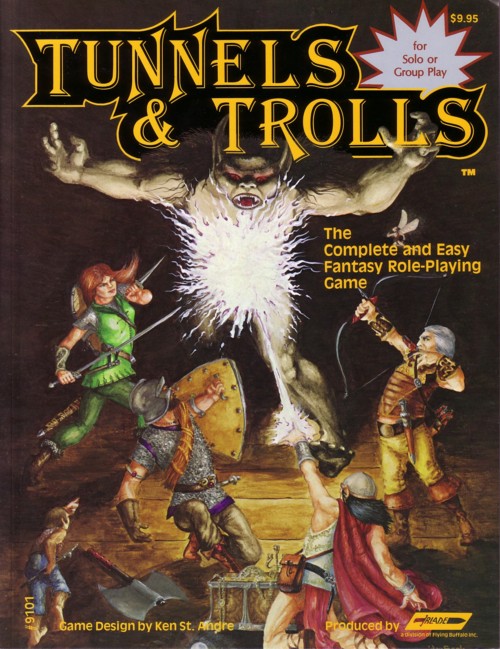
There has been some convergence between the two systems. That Other Game really got into storytelling once Weis and Hickman started doing D&D novels. R.A. Salvatore created comic book heroes and villains in his novels–what is Drizzt but Elric in disguise, and Elric has been done in comics many times. The Heroes of the Lance as done by Weis and Hickman are a lot like the Fellowship of the Ring or like a comic book version of the Round Table. Stories became a big part of D&D, but they didn’t start that way. Miniatures have become a part of T&T, but they didn’t start that way either.
I don’t expect Tunnels and Trolls to ever have the popularity and recognition that Dungeons &Dragons has, but I really believe that is just chance at work. D&D got some big money behind it early and some great distribution through mainstream stores (bookstores, game stores, department stores). T&T never had big money or distribution.
And then there’s the originality factor. Sometime I’d like the world to know all the fantasy innovations that T&T did before D&D. But that’s another article, and a lot harder to document.
Jeffro: I think more and more people are giving Tunnels & Trolls a serious look. The person who sold me on the importance of the system is Kyrinn S. Eiss, who wrote this in the introduction to her Porphyry: “Please realize that more than almost any other game still in commercial production, Tunnels & Trolls (and MSPE) is flexible and utterly independent of endless rules books; Ken, Liz, Mike and company having delivered all that you would ever need to stimulate your group’s imagination while laying a solid foundation off which to build your own games.”
And I’ve got to say… there is a modest number of people that would want to see your superhero rules. (I’ve never been satisfied with how those have been done.) Also… the Lovecraft variant of T&T that appeared in Sorcerer’s Apprentice #7 sounds like something game historians need to know about! (If you could pull some strings and get Rick Loomis to get a PDF of that out, it would make a modest number of people really happy.)
The other game people really want to know about is Stormbringer, which you worked on with fellow gaming legend Steve Perrin– and swords & sorcery author Michael Moorcock. Can you tell about the creation of that game? (It’s also highly regarded in the game blog scene as being particularly innovative.)
Ken St. Andre: Jeffro, you seem to have a misconception about how Stormbringer came to be written.
First, Chaosium acquired the gaming rights to Moorcock’s fiction after TSR used Moorcock’s creations without permission. Stafford actually paid Moorcock or his agent some amount of money to do games based on Moorcock’s writing.
Second: I heard that Chaosium was going to do an Elric rpg. At the time I was a huge fan of Moorcock’s writing and had even created a fantasy diplomacy variant of the Young Kingdoms. I was friends with Stafford and the Chaosium crew mostly because of the nice thing Greg said about T&T in the first edition of RuneQuest. I wrote Greg a letter and told him that I’d like to develop the Stormbringer game for him. I pitched him two concepts I wanted to use. True D100 based skills instead of d20s and Magic based on the summoning and binding of demons and elementals. Greg liked my ideas and gave me the job.
Third: Steve Perrin was on staff at Chaosium at the time. Greg assigned Steve to be my editor. Steve was extremely helpful to me in creating the rules, especially when it came to defining the Gods of Law. So helpful that I told Greg that Steve deserved a co-author credit. He got it.
Fourth: Moorcock was never involved with the process of creating the games at all. After he saw my finished version of the game, he wrote a nice letter to the Chaosium saying that we had noticed things about the Young Kingdoms that surprised and pleased him. I don’t think Moorcock had any interest in fantasy roleplaying gaming at the time. He took his money, never interfered, and went on about his merry way as if the Chaosium adaptations of his fiction into gaming form as if it never existed.
And that’s about it. The wonderful collaboration you imagine never existed. I wrote game rules in Arizona. Steve edited them into shape in California. God only knows where Moorcock was at the time.
Jeffro: Okay, that cleared up things I didn’t even know that I didn’t know about. (!!) I really appreciate you taking the time to set things straight here. It is very kind of you and it means a great deal.
Ken St. Andre: Jeffro, thanks for the chance to elaborate on some of my favorite topics. Thanks for scratching the surface again. Any time you wanna go even deeper, just let me know.
—
To keep up with Ken St. Andre on the web, you can find him on Twitter, Facebook, or at his blog. His Trollhalla Press has a range of his work available in PDF format at DriveThruRpg.
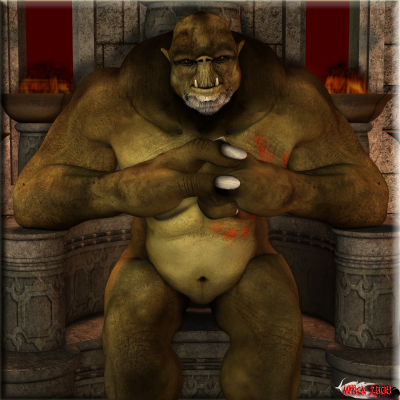
Thanks for posting this.
Good to hear that Ken St. Andre is doing well and has all of his wits about him. Glad to hear a detailed account of how he developed Stormbringer for Chaosium, that cleared up a couple of misconceptions for me.
I’d be interested in hearing anything else he has to say about the old days, and also about the rpg innovations that T&T originated.
Thanks again.
Yes! I hope you will take him up on his offer to delve deeper.
Ken is always fascinating, and one of the nicest guys you could imagine. I continue to insist that TnT was the FIRST rpg published, as OD&D was released and designed as a miniatures wargame with minis representing an individual instead of units.
Blackmoor was definitely the first rpg, but never reached publication for decades, and then as a D20 supplement. (sigh)
